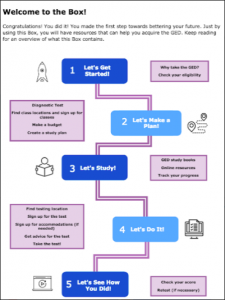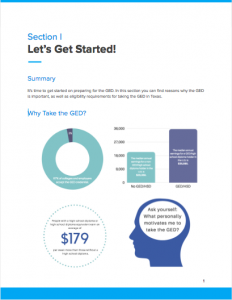Over the past two weeks, we tested at a GED class offered by Houston Center for Literacy as well as with a current underprivileged youth involved with the Salvation Army who is looking to start taking GED classes.
The questions that we asked at the testing sessions to the people taking/interested in taking the GED classes had to do with: their background, why they decided to take a GED class, how much they knew about the GED beforehand, and time commitments outside of studying. We also asked questions to the GED class teachers and asked them about: the knowledge gap and falloff points of the students and how many people follow through and take the GED. After interviewing the students, we showed them either a checklist of everything that would go in our prototype (first testing session) or our actual prototype (second testing session) and then asked them for their feedback on all parts. We asked them if they would find certain things useful, how we could change the content in the box, and overall thoughts on using the box to study for the GED.
We wanted to test the following assumptions:
- They want to take the GED or they can be motivated to take the GED
- They are busy and don’t have much time
- They don’t have access to other resources
- The users don’t really know what they need to do for the GED
At the first testing session at the Houston Center for Literacy, we interviewed 4 adults who were all at least in their mid-30s. Therefore, their demographic did not exactly match the young demographic in the rapid rehousing program of the Montrose Center, but we still got some useful key insights that helped shape our prototype:
- People usually stop coming to GED classes because of other time commitments and money
- People come into the class not knowing much about the GED
- We should move away from the goal of our prototype to be “all encompassing” and focus on it being “supplemental” instead
- We should include other supplemental things, but the main focus should be to get them to go out and be motivated to study
The second testing session was with the Salvation Army. We talked to a 20-year old woman who was expecting a child soon and therefore wanted to get a GED so that she could start supporting that child. These were the useful key insights we got from that testing session:
- There may be a lack of access to a computer at home, so we should probably print out important websites.
- It is hard to keep people motivated for long periods of time
- The box would be most helpful if they were taking classes at the same time
- Some people may find too much text difficult to read, so it is important to have visuals
- “It’s like a portable GED class!”
We are using these key insights to shape the contents of the box, and are grateful for the insights that we gained from the interviews.
Here are some of our prototypes after 2 iterations!

